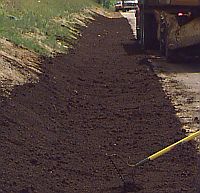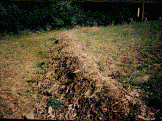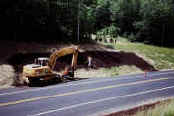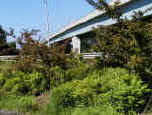Using Compost to Control Soil Erosion, Establish Turf and Amend Planting Backfill: A Research Summary
 |
Introduction
The Connecticut Departments of Environmental Protection and Transportation collaborated on a two-year research project which demonstrated that compost was effective in controlling soil erosion, growing turf, and amending soil used in planting trees and shrubs. The study, funded in part by the US EPA, was based on the premise that if compost were proven to be successful in these applications, this would increase awareness and confidence among the Connecticut transportation and road construction industries about the benefits of using compost and therefore result in higher demand for compost products and the creation of jobs to satisfy this demand. It was also presumed that if ConnDOT adopted a materials specification and construction details for compost based on the results of the study, then municipalities, landscapers, soil blenders, etc., would follow suit and begin to use more compost in roadside development and other soil-related projects.
The study utilized compost derived from yard trimmings (mostly leaves) which is the most locally available, affordable, and abundant kind of compost in Connecticut. Compost was donated by the Town of Manchester and EarthGro Inc, and wood mulch was donated by the Town of Glastonbury. Laboratory analysis and field installations were utilized to characterize the compost and its behavior under different conditions. The study focused on three applications for which ConnDOT had anticipated a need for compost: erosion control, turf establishment and soil amendment for plantings. In addition, wood mulch (ground brush and clean wood) was also studied for use as a "filter berm" medium to retain storm water sheet flow long enough to filter sediment.
Study Area Locations, Design and Results
Soil Erosion Control
 The first installation took place at a ConnDOT road reconstruction project at the intersection of Routes 198 and 6 in Chaplin, CT. Eight 35' x 10' study cells were constructed on a 2 horizontal to 1 vertical (2:1) slope of silty sand. Cells were separated from each other and the surrounding area by recessing 1" x 6" boards into the soil, and were lined with plastic sheets so that storm runoff and eroded soil could be directed from individual cells to a series of collection buckets at the bottom of the slope. Each cell was treated differently with compost, wood mulch, hay & straw, filter berm and a control of bare soil. Some cells were seeded, others were not. After storm events, water which had collected in the buckets was sampled and tested for suspended solids, metals and nutrients.
The first installation took place at a ConnDOT road reconstruction project at the intersection of Routes 198 and 6 in Chaplin, CT. Eight 35' x 10' study cells were constructed on a 2 horizontal to 1 vertical (2:1) slope of silty sand. Cells were separated from each other and the surrounding area by recessing 1" x 6" boards into the soil, and were lined with plastic sheets so that storm runoff and eroded soil could be directed from individual cells to a series of collection buckets at the bottom of the slope. Each cell was treated differently with compost, wood mulch, hay & straw, filter berm and a control of bare soil. Some cells were seeded, others were not. After storm events, water which had collected in the buckets was sampled and tested for suspended solids, metals and nutrients.
As expected, all of the treated cells significantly reduced erosion as compared to the untreated control cells (bare soil), and the compost treatments performed as well or better than the conventional ConnDOT treatment of hay and seed. Erosion levels on the bare soil cells were more than an order of magnitude greater than the erosion for any of the treated cells. While there was small variation in erosion resistance among treated cells, there appeared to be little correlation to type of treatment, seeding or thickness of treatment. For example, a cell treated with 1 1/2 inches of compost had a loss of sediment equivalent to a cell treated with three inches of compost. Soluble salts concentration in the runoff was very low and all metals and nutrients were well within pollution leaching limits and Connecticut drinking water standards. Samples from one cell during the first rainfall after construction of the installation had slightly elevated chloride concentration, but was still within drinking water standards. Only very low levels of chloride were released from this cell during subsequent storms.
Filter Berm
 This installation was immediately adjacent to the previously discussed test site. A berm of wood mulch measuring approximately 12" high, 48" wide at the base, and 50' long was constructed at the toe of slope. The function of the berm was to slow storm water velocity down long enough to allow the sediments to settle out and to filter the water as it passed through the berm to the other side.
This installation was immediately adjacent to the previously discussed test site. A berm of wood mulch measuring approximately 12" high, 48" wide at the base, and 50' long was constructed at the toe of slope. The function of the berm was to slow storm water velocity down long enough to allow the sediments to settle out and to filter the water as it passed through the berm to the other side.
No quantitative measurements were made for this filter berm installation as were made in the study cells mentioned above. However, qualitative observations revealed that the test was completely successful. Soil which had been eroded from the slope was contained behind the filter berm. After the field tests were complete, the berm was carefully dissected. Little or no soil was found to have penetrated the berm beyond the first one or two inches. In order for this to work properly, the wood mulch needed to have both coarse particles to allow water to penetrate and fine particles to retain the eroded soil.
Turf Establishment
 Three study areas were chosen to test the use of compost in turf establishment. Two were located on Route 6 directly east of the intersection of Route 198, and the other on the south side of Route 6 opposite the Mansfield Dam. Again, these installations were more qualitative than quantitative in nature and were meant to verify what had been observed on the test cell site. Two of the three areas were situated at the edge of pavement, primarily in the drainage swales at the bottom of slopes. Compost was applied to existing backfilled soil at varying rates and compared to a control section containing no compost. Each section was 50' long and 6' wide. Application rates were 2", 1", and 2", each being tilled to a 3" depth. There was also a separate top dressing application of 2". All sections, including the control, were seeded with the standard ConnDOT seed mix and monitored for plant growth. The third area was on a 2 horizontal to 1 vertical (2:1) slope of "dead sand" and received approximately 1 1/2" of compost as top dressing and seed over an area measuring approximately 100' long and 35' wide. This area had been seeded several times before with limited success in establishing turf. Soil samples from each section were tested before and after applications of compost to determine whether it passed the ConnDOT specification for topsoil. The study areas were monitored for plant growth throughout the 1998 growing season.
Three study areas were chosen to test the use of compost in turf establishment. Two were located on Route 6 directly east of the intersection of Route 198, and the other on the south side of Route 6 opposite the Mansfield Dam. Again, these installations were more qualitative than quantitative in nature and were meant to verify what had been observed on the test cell site. Two of the three areas were situated at the edge of pavement, primarily in the drainage swales at the bottom of slopes. Compost was applied to existing backfilled soil at varying rates and compared to a control section containing no compost. Each section was 50' long and 6' wide. Application rates were 2", 1", and 2", each being tilled to a 3" depth. There was also a separate top dressing application of 2". All sections, including the control, were seeded with the standard ConnDOT seed mix and monitored for plant growth. The third area was on a 2 horizontal to 1 vertical (2:1) slope of "dead sand" and received approximately 1 1/2" of compost as top dressing and seed over an area measuring approximately 100' long and 35' wide. This area had been seeded several times before with limited success in establishing turf. Soil samples from each section were tested before and after applications of compost to determine whether it passed the ConnDOT specification for topsoil. The study areas were monitored for plant growth throughout the 1998 growing season.
 Results showed that amending backfilled soil with moderate amounts of compost significantly improves turf establishment. There were fewer and smaller plants in the sections containing no compost, as compared to lush growth in the compost amended sections. Differences were less obvious between sections containing varying application rates suggesting that even a little compost (2" top dressing or 1" tilled to a 3" depth) will have a positive effect. In addition, the control section (standard ConnDOT soil backfill) did not pass the specification for topsoil, whereas the compost-amended sections did. It should be noted, however, that ConnDOT did not specify topsoil for use in this area, and that testing for compliance with the topsoil specification was done only for comparison between the control and the compost amended study sections. Soil analyses also revealed that compost increased the moisture holding capacity, and improved the pH of the backfill soil to the point of eliminating or significantly reducing the requirement for the addition of lime. The compost application on the 2:1 "dead sand" slope not only produced turf, but held up to a 6" rain storm only a few days after application, proving the ability of compost to resist and help prevent erosion.
Results showed that amending backfilled soil with moderate amounts of compost significantly improves turf establishment. There were fewer and smaller plants in the sections containing no compost, as compared to lush growth in the compost amended sections. Differences were less obvious between sections containing varying application rates suggesting that even a little compost (2" top dressing or 1" tilled to a 3" depth) will have a positive effect. In addition, the control section (standard ConnDOT soil backfill) did not pass the specification for topsoil, whereas the compost-amended sections did. It should be noted, however, that ConnDOT did not specify topsoil for use in this area, and that testing for compliance with the topsoil specification was done only for comparison between the control and the compost amended study sections. Soil analyses also revealed that compost increased the moisture holding capacity, and improved the pH of the backfill soil to the point of eliminating or significantly reducing the requirement for the addition of lime. The compost application on the 2:1 "dead sand" slope not only produced turf, but held up to a 6" rain storm only a few days after application, proving the ability of compost to resist and help prevent erosion.
Planting Backfill
 The final field test involved using compost in the planting soil mix (planting backfill) for trees and shrubs. The Interstate 91/Route 3 interchange was chosen, since this ConnDOT project was nearing completion and ready for landscaping. Two planting areas were designated, one having a southeast exposure, the other having a northwest exposure. The plantings in these two areas were divided so that some plants received treatment with compost and others of the same species were designated as a control. In the Fall of 1997, Sugar Maple, Eastern White Pine, Doublefile Viburnum, Border Forsythia, Dwarf Winged Euonymus and Northern Bayberry were planted in accordance with the ConnDOT planting specification, with the exception that in the treated plants, compost was substituted for peat. The planting backfill in the treated plants consisted of 1 part compost to 2 parts planting soil. All plants were mulched with wood chips after installation and the ones containing compost were tagged.
The final field test involved using compost in the planting soil mix (planting backfill) for trees and shrubs. The Interstate 91/Route 3 interchange was chosen, since this ConnDOT project was nearing completion and ready for landscaping. Two planting areas were designated, one having a southeast exposure, the other having a northwest exposure. The plantings in these two areas were divided so that some plants received treatment with compost and others of the same species were designated as a control. In the Fall of 1997, Sugar Maple, Eastern White Pine, Doublefile Viburnum, Border Forsythia, Dwarf Winged Euonymus and Northern Bayberry were planted in accordance with the ConnDOT planting specification, with the exception that in the treated plants, compost was substituted for peat. The planting backfill in the treated plants consisted of 1 part compost to 2 parts planting soil. All plants were mulched with wood chips after installation and the ones containing compost were tagged.
Using compost to amend planting soil was very successful. An inventory was conducted in the Spring of 1998 which consisted of counting all the plant material and identifying which ones needed replacing. During this inventory, it was noted that none of the plants planted in compost needed replacing (i.e. the mortality rate was zero percent), compared to a mortality rate of approximately 40% in the standard ConnDOT control plants. Another inspection conducted in the Fall of 1998 confirmed that the survival rate for the compost amended plants was still 100%. There was no apparent difference in condition between plants planted in compost and those planted without compost. It is possible that more than one growing season will be required before any significant differences may be observed.
ConnDOT Compost Specifications
As a result of the success achieved through these field trials, ConnDOT has adopted a materials specification for compost and a construction detail which allows the substitution of compost for peat in planting backfill. The specifications can be found in ConnDOT's Form 816 "Standard Specifications for Roads, Bridges and Incidental Construction" and read as follows:
M.13.06 -- Compost: Compost shall be a stable, humus-like organic material produced by the biological and biochemical decomposition of source separated compostable materials, separated at the point of generation, that may include, but are not limited to, leaves and yard trimmings, food scraps, food processing residuals, manure and/or other agricultural residuals, forest residues and bark, and soiled or non-recyclable paper. Compost shall not be altered by the addition of materials such as sand, soil or glass. Compost shall contain no substances toxic to plants and shall not contain more than 0.1 percent by dry mass of man-made foreign matter. Compost shall pose no objectionable odor and shall not closely resemble the raw material from which it was derived. Compost shall have a minimum organic matter content of 30 percent dry unit weight basis as determined by loss on ignition in accordance with ASTM D 2974. Compost shall be loose and friable, not dusty, have no visible free water and have a moisture content of 35 - 60 percent in accordance with ASTM D 2974. The particle size of compost shall be 100 percent less than 25 mm in accordance with AASHTO T27 and shall be free of sticks, stones, roots or other objectionable elongated material larger than 50 mm in greatest dimension. The pH of compost shall be in the range of 5.5 - 8.0. The maturity of the compost shall be tested and reported using the Solvita Compost Maturity Test and must score 6 or higher to be acceptable. The soluble salt content of compost shall not exceed 4.0 mmhos/cm as determined by using a dilution of 1 part compost to 1 part distilled water. Compost may be either commercially packaged or used in bulk form. All compost material must be from DEP regulated, permitted or approved facilities. All compost material must be environmentally acceptable and must be accompanied by a Materials Certificate and Certified Test Report in accordance with Section 1.06.07. The Engineer reserves the right to draw samples and perform tests as may be deemed necessary to assure that the material conforms to these specifications.
M.13.07.13 --Peat:
(b) Compost conforming to Article M.13.06 may be substituted for peat.
Where to Find Compost
By state regulation, leaves are a mandatory recyclable item which means they should not be disposed in a landfill or incinerator. They must be recycled, and the most common way to recycle leaves is to turn them into compost. There are now about 100 leaf composting facilities registered with the CT DEP, most of which are municipally owned and process town generated leaves. Municipal operations tend only to accept leaves generated in that town, and may also provide small quantities of finished compost to residents for free or at a nominal charge. There are also several private leaf composting facilities which have been established in response to the demand for purchasing finished compost and for places to recycle leaves. Private facilities will usually accept leaves from many different sources and have larger quantities of compost available for bulk sale. Some of the private facilities and some farms may also be permitted to accept other types of source separated organics, such as manure, spent mushroom growing medium, and food processing residuals and therefore may have a variety of compost products to offer.
It should be noted that not all compost products are created equal. Some facilities are better able to process organics because they have specialized equipment such as mechanical turners and screens, or put more time and effort into the composting process, and therefore may have a better quality compost. It is always a good idea to visit the compost facility and visually check the quality of the compost before purchasing bulk quantities.
A separate fact sheet entitled "Potential Sources of Compost in Connecticut" has been developed to help consumers locate sources of compost.
For More Information
For information about composting please visit our Composting & Organics Recycling web page.
For information about use of compost on ConnDOT projects (specifications, research, etc.), please contact:
Mr. Robert Lauzon
ConnDOT Division of Materials Testing
280 West Street, Rocky Hill, CT 06067
Phone: 860-258-0312
Fax: 860-258-0399
e-mail: robert.lauzon@ct.gov
Content Last Updated February 14, 2020

